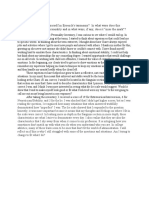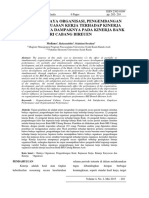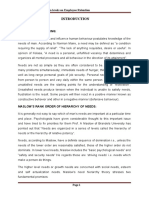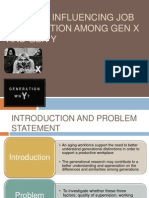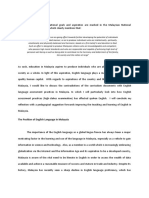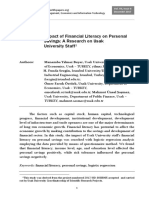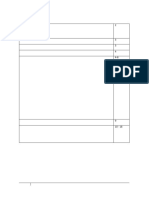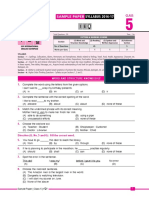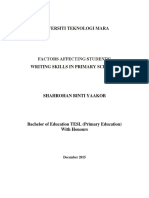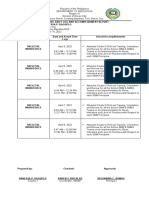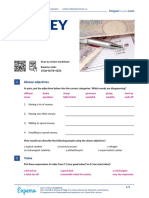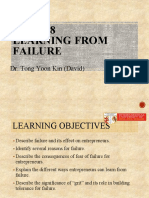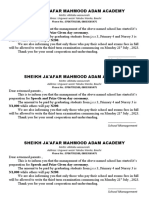Effect of Competence, Organizational Culture and Climate of Organization To The Organizational Commitment, Job Satisfaction and The Performance of Employees in The Scope of Makassar City Government
Effect of Competence, Organizational Culture and Climate of Organization To The Organizational Commitment, Job Satisfaction and The Performance of Employees in The Scope of Makassar City Government
Uploaded by
inventionjournalsCopyright:
Available Formats
Effect of Competence, Organizational Culture and Climate of Organization To The Organizational Commitment, Job Satisfaction and The Performance of Employees in The Scope of Makassar City Government
Effect of Competence, Organizational Culture and Climate of Organization To The Organizational Commitment, Job Satisfaction and The Performance of Employees in The Scope of Makassar City Government
Uploaded by
inventionjournalsOriginal Title
Copyright
Available Formats
Share this document
Did you find this document useful?
Is this content inappropriate?
Copyright:
Available Formats
Effect of Competence, Organizational Culture and Climate of Organization To The Organizational Commitment, Job Satisfaction and The Performance of Employees in The Scope of Makassar City Government
Effect of Competence, Organizational Culture and Climate of Organization To The Organizational Commitment, Job Satisfaction and The Performance of Employees in The Scope of Makassar City Government
Uploaded by
inventionjournalsCopyright:
Available Formats
International Journal of Business and Management Invention
ISSN (Online): 2319 8028, ISSN (Print): 2319 801X
www.ijbmi.org || Volume 5 Issue 4 || April. 2016 || PP52-64
Effect of Competence, Organizational Culture and Climate of Organization
to the Organizational Commitment, Job Satisfaction and the Performance
of Employees in the Scope of Makassar City Government
Andi Syahrum1, Prof. Dr. Drg. Hj. Ida Aju Brahmasari1, Dr. Riyadi Nugroho1.
1
(Doctorate Program, Universitas 17 Agustus 1945, Surabaya, Indonesia)
ABSTRACT: This study analyzes the effect of competence, organizational culture and climate of
organization to the organizational commitment, job satisfaction and the performance of employees in
the scope of Makassar city Government. The population of the study was government employees of
Makassar city governmant occupying echelon 2,3 and 4 which ammounted to 453 people. The number
of samples used were 298 people. This research uses Structural Equation Modelling (SEM) as
analysis technique. Based on analysis results and hypotheses testing, the conclusions of this research
are the competence has positive significant effect to the organizational commitment, work satisfaction
and the employees performance; organization culture has positive influence on the organizational
commitment, work satisfaction and the employees performance; organization climate also has
positive impact on the organizational commitment, work satisfaction and the employees performance.
In the other side, organizational commitment positively affect the job satisfaction and employees
commitment.
KEYWORDS Competence, Organizational Culture, Climate of Organization, Job Satisfaction, Employees
Performance, Makassar City Government
I.
INTRODUCTION
Human resources is a decisive factor in the activities of government organizations, without the function
and role of human resources, any event will not be run in accordance with the expected goals. One of the factors
that determine the success or failure of an organization is its human resources organization. Understanding the
behavior of each individual to be a resource in the organization and an indicator to measure the success in
achieving organizational goals (Mujanah, 2014: 1).
Competence of human resources is a factor supporting the achievement of organizational goals.
According to Hutapea (2008: 4) that the competence is a composition that is the person who can make that
person is able to fulfill what is implied by the work of an organization, so that the organization is able to deliver
the expected results. The importance of human resources, the human resources has high competence will affect
the performance of civil servants, particularly in an organization. These results are consistent with research
conducted by Hadiyatno (2012: 2) examine the effect of competence, compensation to employee performance.
The results showed that simultaneous competencies, compensation and job satisfaction have a significant effect
on employee performance.
Another factor that affects organizational commitment, job satisfaction and employee performance is
the culture of the organization. Organizational culture is an important part of an organization, because according
Torang (2013: 68) that organizational culture can be said to constitute the norms that have been agreed to decide
on organizational behavior in organizations. Badeni (2013: 59) argues that organizational culture is everything
that rated organization and should be developed, maintained or altered to create an organization that is effective
and efficient in achieving objectives. The implementation of organizational culture within government agencies
have an impact on job satisfaction, commitment and performance employees. Research conducted by
Brahmasari and Suprayetno (2008: 56) who were investigating the effects of work motivation, leadership and
organizational culture on employee job satisfaction and its impact on company performance in PT. Pei Hai
International Wiratama Indonesia.
The study found that motivation, leadership and organizational culture positive and significant impact
on employee job satisfaction and impact on employee performance improvement. Indraswari (2012), which
examines the influence of organizational culture on job satisfaction and motivation and performance of
employees at PT. Telkom Regional IV Semarang. The results showed that motivation and organizational culture
striving to work satisfaction with employee performance. Then other researchers are Sunaryo (2011) examined
the impact of organizational culture on job satisfaction. The results showed that organizational culture influence
on job satisfaction.
www.ijbmi.org
52 | Page
Effect of Competence, Organizational Culture and Climate
Another factor is the organizational climate and organizational climate on job satisfaction which is in
line with previous research which Susanty (2012) examined the effect of organizational climate on job
satisfaction and employee commitment to the Open University. The results showed that organizational climate
had no significant effect on job satisfaction, but the effect on organizational commitment.
Research conducted by Kurnia Sari (2013) investigated the influence of the work environment and
organizational climate to work commitment through employee satisfaction in the Market Office Market Unit at
Regency Tanjung Jember. The result study found that the work environment and organizational climate on job
satisfaction. According to Karundeng (2013) examined the effect of organizational climate on employee
performance. The study found that organizational climate on employee performance, especially at PT. TASPEN
(Persero) Branch Manado.
Factors that can increase employee performance is the organizational commitment. According to
Sopiah (2008: 62) that organizational commitment is a psychological bond of employees in an organization
characterized by the trust and acceptance of the strong over the goals and values of the organization, willingness
to striving for interests of the organization, a strong desire to maintain a position as a member of the
organization, Kotler and Beskett (1997: 110), entitled corporate culture and performance to conclude that
corporate culture has a very dominant influence on the success or failure of the company in building
performance, organizational culture has a positive impact on the economic performance of companies.
Other factors that can increase the performance of employees is job satisfaction. According Sunyoto
(2012: 65) that job satisfaction is an emotional state that is pleasant or unpleasant. So with high employee
satisfaction will affect employee performance. Research conducted by Indrawati (2013) entitled influence job
satisfaction on the performance of employees at Private Hospital in Denpasar, the research found that job
satisfaction has a significant and positive effect on employee performance.
The other study was conducted by Zhang (2010) examined the organizational climate and its effects on
an empirical study of organizational variables. The study found that the characteristics of the organizational
climate variables affect the organization, which is shown as follows: education level, position and length of time
working for the organization at this time was a significant main effect of organizational climate; Specifically,
the character of the company and the size of the company also has a significant main effect of organizational
climate; organizational climate had a significant main effect on the effectiveness of human resource
management such as turnover intentions, job satisfaction and job performance of employees; organizational
climate also had a significant main effect on the effectiveness of the organization such as organizational
commitment of staff members and collective identity.
The last few years based on our observation as one of the clerks in the scope of the Government of
Makassar that employees performance decreased when officers PNS always required to provide services to the
public, so that public services are organized by the local government in regional autonomy is expected to
increase public satisfaction of any services provided by local governments. The phenomenon encountered in the
scope of government in the city of Makassar is the quality of work produced by each employee is still low.
Some things that can affect the decline in the performance of employees, among others employees
competence themselves, the organizational culture in every office and organizational climate can ultimately
affect the organizational commitment and job satisfaction. then do research on the factors that influence
employee performance decline. Based on the description turns within the scope of an employee of the
Government of Makassar City overall employees performance on average showed the value of adequate
performance, it is in line with the results of previous studies that employee performance is strongly influenced
by their competence, organizational culture and organizational climate, organizational commitment and job
satisfaction.
II.
LITERATURE REVIEW
2.1.
Competence
The word "competence" has highlighted aspects of understanding and emphasis relatively distinct.
Competence has the same meaning as capability (ability). Someone competent is who has the ability, knowledge
and expertise to do things efficiently and effectively. Every organization, private or public need to develop
human resources (HR) owned professional and have high competence. Human resources highly competent
organization will become a center of excellence as well as support organizational competitiveness in entering
the era of globalization and face the business environment as well as social conditions are changing so fast.
The role of human resources in the organization has the same meaning as important as the work itself, so
that the interaction between the organization and human resources became the focus of attention of the manager.
Therefore, the values that complies with the demands of the organization's environment needs to be introduced
and socialized to all individuals in the organization. Organizations in the future will be shaped around a human.
Then less emphasis on tasks as a unit to build the organization. It means that it is centered on human
competence. If humans are used as a development organization, then what do they bring to the job that
competence becomes very important.
www.ijbmi.org
53 | Page
Effect of Competence, Organizational Culture and Climate
To obtain maximum benefit from the opportunities provided by the types of the new organization, the
necessary forms of human resource management more integrated, which is based on a clear understanding of the
competencies required for the role (rather than from a job or task) management so requires a sharper picture of
the strengths and weaknesses of the real nature of people. Given the large sense of competence raised in the
dictionary and also by the experts, the following describes some sense of competence. According to Makmur
(2013: 237) competence is as skills that should be developed by the staff when he wants to show the
performance that meet the standards are fully satisfy their jobs. Formation of the competence of the government
apparatus not appear by itself but through a long process and use a long time, because it is theoretically
competence or the ability to form the government intelligence apparatus which is applied through proper
thought and action as well as profitable.
Definition of competence as stated by Hutapea (2008: 4) that the competence of the existing capacity in
someone who can make a person able to fulfill what is required by the job within an organization so that the
organization is able to achieve the expected results. Suparno (2005: 24) that the competence contains aspects of
knowledge, skills and the ability or personality characteristics that influence performance. In contrast to Fogg
(2004: 90) that divides competences into two (2) categories:
1. Basic competencies and differentiate basic competencies (threshold) and
2. Competence differentiator according to criteria that are used to predict the performance of a job. Basic
competence (threshold competencies) are the main characteristics, which is usually in the form of
knowledge or basic skills such as the ability to read, while differentiating competencies are competencies
that make a person different from another.
2.2.
Organization Culture
The concept of organizational culture became popular since the early 1980s. The term culture of the
organization known as the organizational culture terminology. Then, in a variety of management science
literature is becoming more popular with corporate culture terminology. In the literature, there is no consensus
or agreement on the definition of the organization's culture. In fact, often found the perception or understanding
of the concept of organizational culture is synonymous with national culture or even no different with climate
organization organizational climate. The concept of organizational culture with the national culture and the
organizational climate. Culture, or culture manifests from the surface to depth in symbols, spirit, rituals and
values. At the level of the nation's cultural values, while the organizational culture at the level of symbols, spirit,
ritual together, and practices. (Tika, 2008: 56). Organizational culture consists of two things; that are visible or
invisible (visible artifacts) and are not visible (invisible). Cultural elements that appear include everything that
can be seen by naked eye, such as people behave, dress, speech, symbols, rituals, organization logo, hero
figures, the stories are often discussed the organization's members.
Cultural elements are not visible are the values, assumptions, philosophies, beliefs, thought processes,
which in principle would affect the proper elements. Organizational culture can be formed, created and
engineered to synergistically with the ideals of the organization. Therefore, the task of the leader of the
organization is to build an organizational culture that is in line with the vision and mission of the organization.
As an example of an organization which has the motto "Customer satisfaction is our happiness" is not only
limited to making formal dimension slogan visible artifact, but need to make it as beliefs, principles and
measures for members of the organization. To that end, leaders of the organization and the human resources
department in charge of socialization and internalization motto is meant to be the organization's culture.
In his environment, humans are influenced by a culture where it is located, such as values, beliefs, social
behavior or society which in turn produce social customs or culture. The same thing happened to members of
the organization, with all the values, beliefs and behavior within the organization would then create an
organizational culture (Sopiah, 2008: 135). The above description can be said that the organizational culture is
basically represent the norms of conduct followed by the members of the organization, including those within
the organizational hierarchy. For organizations that are still dominated by the founder, for example, then the
culture will be a vehicle to communicate the expectations of the founders of the other workers. Similarly, if a
company is managed by a senior manager who apply the autocratic leadership style top down. Here culture will
also serve to communicate the expectations of senior managers.
Culture execute complex functions, within the organization. First, the role of culture has set boundaries.
That is, culture of creating a clear distinction between the organization, with the others. Second, culture bring a
sense of identity for the members of the organization. Third, facilitate the emergence of a culture of commitment
to something larger than one's personal self-interest. Fourth, the cultural increase the stability of the social
system. Culture is the social glue that helps unite the organization by providing appropriate standards for what
should be said and done by the employees. Fifth, culture serves as a control mechanism and meaning makers
who facilitate and shape the attitudes and behaviors of employees. Sixth culture will generate commitment and
mission of the organization.
www.ijbmi.org
54 | Page
Effect of Competence, Organizational Culture and Climate
Organizational culture is a social force that is not visible and can move people in an organization to
perform work activities so according Torang (2013: 69) There are 13 indicators to measure organizational
culture that is the style of leadership, communication of patterns, style of decision making, use of information,
level of classifications and privileges, concequences of failure, the space of the layout, norms and behavior,
mythos stories, traditions and rituals, heroes, symbol-brand-logo, motto, language, relics. While Sembiring
(2012: 59) that the indicators in measuring the organization's culture: innovation, risk taking, results orientation,
attention to details, people orientation and team orientation.
2.3.
Organizational Climate
The organization is a form of human cooperation for the achievement of common goals. Organization is
nothing more than a group of people who gather together around a technology that is used to change the inputs
from the environment into goods and services that can be marketed. Climate organization by Sunyoto (2012: 52)
is a set of feelings and perceptions of the various workers who may change from time to time and daeri one
worker to another worker.
How organizational climate beneficial to the individual needs of example consider the interests of
workers and achievement-oriented, then we can expect the level of behavior toward high goal. Conversely,
when the climate arising contrary to the objectives, needs and personal motivation, it can be expected that the
achievement and satisfaction will be reduced. In other words, the final outcome or behavior is determined by the
interaction between the needs of individuals with environmental organizations that they feel. The level of
achievement, satisfaction and so generated can then feed back and contribute not only to the climate of the
working environment is concerned, but also on possible policy changes and management practices.
Understanding organizational climate proposed by Simamora (2006: 56) stated that the organizational
climate is the internal environment or psychological organization. Organizational climate affects HR practices
and policies adopted by the organization's members. Keep in mind that each organization will have a different
organizational climate. Diversity work designed in the organization, or individual nature there will reflect these
differences.
All organizations certainly have a strategy in menanajemen HR. Open organizational climate to spur
employees to express their interests and grievances without fear of reprisal and attention. Such discontent can be
handled in a way that is positive and thoughtful. A climate of openness, however, is only created if all members
have a high level of confidence and trust justice action.
Climate is important organization to be created because it is one's perception of what is provided by the
organization and provide a basis for determining the behavior of members of the next. Climate is determined by
how well member directed, built and valued by the organization. Definitions of organizational climate can be
seen in the dimensions of the organizational climate. Likert (1986: 101) to measure the organizational climate
by developing a classic instrument that focuses on management style. Survey Likert includes several factors:
leadership, motivation, communication, interaction, decision making, goal setting, and control. In this case,
respondents were asked to choose according to his view on each item indicating autocratic tendencies in the
organization, structuring high or participatory and human-oriented. The conclusion from this study is that the
human-oriented organization, produce a level of achievement (performance) and higher levels of job satisfaction
is higher also.
Commitment to the organization is a feeling of obligation on the employee to remain in the organization
that is the result of pressure to go in or go in an organization. Affective commitment concerning the emotional
provide greater benefits to the organization which is to reduce employee turnover, increase productivity and
higher job satisfaction. This compared with the commitment of employees, based on the financial aspects of
bringing harm to the organization are employees who are experienced will try to find a job outside the
organization more profitable which would reduce job satisfaction in the organization and the award high self
will lead to loss of experienced employees (Tika 2008: 68).
So someone who has a high commitment to the organization will have identification, engaged earnestly
and loyalty with affection there positively to the organization. Besides performing behavioral work towards the
organization's goals and desire to remain joining the organization in the long term. Organizational commitment
is a psychological bond of employees in an organization characterized by strong trust and acceptance on the
goals and values of the organization, packaging striving for interests of the organization, a strong desire to
maintain a position as a member organisasi. Dunham, et al. (1994: 370) there are four indicators used to measure
the organizational commitment is proud as workers, engaged in the task, the progress of the organization, and
employee behavior.
2.4.
Job Satisfaction
One important tool in the management of human resources in an organization is the creation of job
satisfaction of employees or employees. Here notions of job satisfaction, according to some experts as
www.ijbmi.org
55 | Page
Effect of Competence, Organizational Culture and Climate
dikemukakakan by Martoyo (2007: 115) is basically a psychological aspect that reflects one's feelings toward
his work, he will be satisfied with the fit between the capabilities, skills and expectations with the job he faced ,
Satisfaction is actually a state of nature is the result of subjective conclusions based on a comparison of what is
received by an employee from work compared with the expected, desired, and thinking as the proper thing or
entitled to it. While every employee subjectively determine how the work was satisfactory.
Rival (2009: 475) satisfaction is an evaluation that describes someone for feeling happy or disgruntled
attitude in work. Job satisfaction is basically something individual. Each individual has a level of satisfaction
varies according to the value system that applies to him. The higher the assessment of the perceived activities in
accordance with the wishes of individuals, the higher the satisfaction with the activity. So the outline of job
satisfaction can be defined as a pleasant or unpleasant that where an employee sees its job.
Job satisfaction is one of the important factors that affect life satisfaction, because most of the time
humans spent at work. Work satisfaction according to Setiawan and Ghozali (2006: 159) is a pleasant condition
or emotionally positive that comes from one's judgment on the job or work experience, Handoko (2008: 193)
states that job satisfaction is an emotional state that is pleasant or unpleasant by which employees view their job.
The opinion can be understood that an employee should be placed on the work according to ability and
background skills. Job satisfaction according Hasibuan (2008: 202) is a pleasant emotional disposition and loves
his job. This attitude is reflected by the morale, discipline and work performance. Enjoy job satisfaction in the
job, off the job, and a combination of inside and outside of work.
Job satisfaction in work is the job satisfaction of interest in the job by gaining praise the work,
placement, treatment, equipment and atmosphere of a good working environment. Employees who prefer to
enjoy job satisfaction in a job would prefer the work of the remuneration even if the remuneration is important,
satisfaction outside of work is employee satisfaction is enjoyed outside of work with the amount of
remuneration to be received from their work, so that he could buy the necessities -kebutuhannya. Employees
who prefer to enjoy more job satisfaction beyond question the remuneration of the execution of his duties.
Job satisfaction is a combination of inside and outside of work is job satisfaction, as reflected by the
balance between the emotional attitude of remuneration with the implementation of the work. Employees who
enjoy more job satisfaction combination of inside and outside work will be satisfied if the work and reply to
services deemed fair and reasonable. More accurate understanding of job satisfaction can be achieved if an
analysis of job satisfaction is associated with job performance, absenteeism, desire to move, worker's age, level
of position and size of the organization.
The same thing was stated Robbins (2005: 119) job satisfaction indicates compatibility between one's
expectations were raised by the remuneration provided by the job. While Luthans (2006: 99) adds job
satisfaction is the difference between how much something for which he should receive) .Malthis and Jakson
(2006: 87) argues job satisfaction is a positive emotional expression which is the result of the evaluation of work
experience. Handoko (2008: 193) states that job satisfaction or the emotional state of pleasant or unpleasant by
which employees view their job. Job satisfaction reflects one's feelings toward his work. It seems the positive
attitude of employees towards work and everything he faced in the work environment. Personnel department or
management should constantly monitor job satisfaction, because it affects absenteeism, labor turnover, morale,
complaints and problems other vital personnel.
2.5.
Employees Performance
Companies can develop is the desire of every individual residing within the company, because each
individual is expected with the development of the company is able to compete and to follow the progress of
time. Therefore, the purpose of which is expected by the company can be reached well. The company's progress
is influenced by environmental factors that are internal and external. The extent to which the company's goal has
been achieved can be seen from how much the company meets the demands of the environment. Meeting the
demands of the environment means it can take advantage of opportunities or overcome environmental
challenges or threats from the environment in order to deal with or meet the demands and changes in the
corporate environment (Riva, 2009: 547).
The promotion and development of new employees and old in the company is one of several activities in
order to adjust to the changes and development of employees, because it is necessary for an assessment of the
work that has been carried out by employees or called with the performance assessment or performance
appraisal (Rival 2009 : 547). Employee performance is influenced by a variety of personal characteristics of
each individual. In the development of a competitive and globalized, companies need employees who are high
achievers. In the further development workers need feedback on their performance as a guide for their actions in
the future, therefore, the assessment should illustrate the performance of the employee (Rival 2009: 547).
www.ijbmi.org
56 | Page
Effect of Competence, Organizational Culture and Climate
Most of the work has more than one job criteria or dimensions. Often certain individuals show better
performance on some criteria for certain jobs than others. In addition, some criteria may be more important than
others for the organization. Weights can be used to indicate the relative importance of several criteria for
employment in one job. All employers want employees do their jobs well. However, an effective performance
management system increases the likelihood that such performance will be realized.
The performance management system (performance management system) consists of a process to
identify, encourage measures to evaluate, improve, and reward employee performance. Employee performance
and organizational performance has a very close relationship. Achievement of organizational goals can not be
separated from the resources owned by an organization that is driven or run employees play an active role as
actors in an effort to achieve these goals. Achieving maximum performance will not be separated from the role
of bureaucracy leader in motivating subordinates in carrying out the work efficiently and effectively.
Improve the performance of an employee required an assessment of performance called performance
appraisal. The performance assessment generally includes both qualitative and quantitative aspects of the
implementation work. Assessment of performance is one of the fundamental functions of personnel, which is
sometimes also called the study of performance, employee assessment, job evaluation, personnel evaluation, or
a ranking personnel. All of these terms refer to the process of the same. Assessment of performance as a whole
is a different process of job evaluation. Job evaluation determines how high a valuable job for the organization
and as such, the salary range should be given to the work.
III.
RESEARCH METHODS
3.1. Conceptual Framework
Job satisfaction and employee performance is a fundamental factor, especially in the spheres of
government. Because their job satisfaction will be able to improve employee performance. Lijan (2012: 135)
that the interests of managers and job satisfaction tends to be centered on the effective performance of
employees. Lijan (2012: 137) that job satisfaction is significantly related to employee performance, but in
improving job satisfaction will affect the performance of employees is determined by their organizational
commitment. This is consistent with the theory put forward by Sopiah (2008: 65) that high organizational
commitment that will have an impact on employee satisfaction and employee performance and ultimately
decreases absenteeism.
H3
Competence
(X1)
H1
H2
Organizational
Commitment (Z1)
H4
Organization
Culture (X2)
H10
Employees
Commitment (Y1)
H5
H7
Organizational
Climate (X3)
H6
H11
H12
Job Satisfaction
(Z2)
H8
H9
Figure 1. Conceptual Framework
Based on the model, the research hypothesis in detail and in detail described as follows:
Hypotheses 1
Hypotheses 2
Hypotheses 3
Hypotheses 4
Hypotheses 5
Hypotheses 6
: Effect of Competence to Organizational Commitment
: Effect of Competence to Job Satisfaction
: Effect of Competence to Employees Performance
: Impact of Organizational Culture to Organizational Commitment
: Impact of Organizational Culture to Job Satisfaction
: Impact of Organizational Culture to Employees Performance
www.ijbmi.org
57 | Page
Effect of Competence, Organizational Culture and Climate
Hypotheses 7
Hypotheses 8
Hypotheses 9
Hypotheses 10
Hypotheses 11
Hypotheses 12
: Organizational Climate Influence on Organizational Commitment
: Organizational Climate Influence on Job Satisfaction
: Organizational Climate Influence on Employees Performance
: Effect of Organizational Commitment to Job Satisfaction
: Effect of Organizational Commitment to Employees Performance
: Impact of Job Satisfaction to Employees Performance
3.2. Data Collection and Sample Characteristics
According Sugiyono (2011: 63) population is generalization region consisting of the objects/subjects that
have certain qualities and characteristics that are determined by researchers to learn and then drawn conclusions.
Based on the theory advanced by Sugiyono (2011) then that becomes the study population was Servants
occupying echelon 2, 3, 4 in the Scope of Government of Makassar. The details of the echelon on the Scope of
Government in Makassar can be presented in Table 1 are:
Tabel 1. Details of Echelon in the scope of the Government of Makassar
Level of
Headcount
Number of
No.
Employment
(N)
Samples (n)
1.
Eselon I
52
11
2.
Eselon II
133
80
3.
Eselon IV
268
121
Total
453
212
The sampling technique used was poportionate random sampling. According Sugiyono (2011: 123) that
proportionate random sampling is used when the population has members/components are not homogeneous and
stratified proportional.
3.3. Data Collection
Data collection techniques used in this study is a survey that is an information-gathering techniques were
done by compiling a list of questions to the respondents in the form of a sample of a population, which in
practice is used instrument questionnaires and documentation questionnaires namely data collection techniques
used by researchers in obtaining data through the respondents to be used in the collection of research data; and
documentation that the data collection techniques used to collect the documents obtained in the Scope of
Government of Makassar. The data obtained regarding the staffing structure at SKPD Scope of Government in
Makassar during 2015.
3.4. Data Analysis
Data analysis techniques used in this research is the analysis of Structural Equation Modeling (SEM)
using Amos release 21. According to Minto (2011: 39) steps in the SEM analysis are: 1) the development of a
theory-based model; 2) Development of flow charts; 3) conversion of flowcharts into the equation; 4) selecting
an input matrix and estimation techniques; 5) assess the problem identification; 6) reliablity test and variance
extract; 7) evaluation models; and 8) the model interpretaion and modification.
IV.
RESULTS
4.1.
Research Data Quality Test
Validity test used to measure whether or not a legitimate or valid questionnaires. A questionnaire
considered valid if the questions in the questionnaire were able to reveal something that will be measured by the
questionnaire (Ghozali, 2009). When the results of the questionnaire below 0.30, it can be concluded that the
limit of the instrument is not valid and should be repaired or discarded. For more details, the validity of test
results of each research indicators can be presented in the following table 2.
Based on Table 2 results of testing the validity of each indicator research, it can be concluded that all
indicators of research has been declared invalid, the reason for the correlation of each indicator range of
research has been on top of the 0.30, so that all research indicators do not need to be repaired or discarded.
Reliability is a tool to measure a questionnaire which showed indicators of variables or constructs. A
questionnaire said to be reliable or reliable if someone answers the statement is consistent or stable over time.
The construct or variable said to be reliable if it gives Cronbach's Alpha> 0.60 (Ghozali, 2009). In
conjunction with the above description it will be presented to the reliability test results are presented in the
following table 3. Table 3 reliability test results from each construct / variable that indicates that everything has
a Cronbach's alpha greater than 0.60, meaning it can be said that any response or respondent in the questionnaire
has been reliable.
www.ijbmi.org
58 | Page
Effect of Competence, Organizational Culture and Climate
No.
1.
2.
3.
4.
5.
6.
Tabel 2. Validity Test Results
Correlation
Variables
Questionnare
Range
Competence
3
0,630 0,754
Organization Culture
6
0,194 0,806
Organization Climate
3
0,534 0,603
Organizational Commitment
4
0,522 0,737
Job Satisfaction
4
0,508 - 0,810
Employees Performance
5
0,598 0,667
No.
1.
2.
3.
4.
5.
6.
Tabel 3. Reliabilty Test Results
Cronbachs
Variables
Alpha
Competence
0,835
Organization Culture
0,878
Organization Climate
0,748
Organizational
0,793
Commitment
Job Satisfaction
0,855
Employees Performance
0,835
Information
Valid
Valid
Valid
Valid
Valid
Valid
Information
Reliable
Reliable
Reliable
Reliable
Reliable
Reliable
4.2.
Model Fit Analysis
Based on the analysis of SEM assumptions, reliability and AVE construct the next step is to analyze the
structural equation modeling (SEM) is a full model. It aims to test models and hypotheses proposed in this
study, the results of data processing by Amos SEM release 20 it will be presented image Structural Equation
Model test results presented in figure 2.
Figure 2. Structural Equation Modelling Test Result
Based on the test image SEM structural equation model it will be presented for feasibility testing models
that can be presented by Table 3.
www.ijbmi.org
59 | Page
Effect of Competence, Organizational Culture and Climate
Tabel 4. Goodnes of Fit Index Evaluation in Model Fit Test
Goodness Of
Cut-Of Value
Results
Information
Fit Index
350.99, where Chi square
df -= 309 ;
Chi square
335,81
Good
Sig. level 5 % = 350,99
Probability
0.05
0,141
Good
GFI
0.90
0,901
Good
AGFI
0.90
0,879
Marginal
1,087
Good
IFI
0.90
0,989
Good
TLI
0.90
0,987
Good
CFI
0.90
0,989
Good
RMSEA
0.08
0,020
Good
CMINDF
Determinant of sample covariance matrix = .016
4.3.
Hypotheses Test Result
Based on the results of the feasibility of the model in the SEM analysis, having known score model fit
then do hypothesis testing. But before it will be presented the results of regression weight of each track testing
that may be presented by Table 5.
Table 5. Regression Weight in SEM Analysis
Estimate
S.E.
C.R.
Organizational Commitment
Path Test
Competence
0,216
0,104
2,082
0,037
Organizational Commitment
Organization Culture
0,212
0,100
2,129
0,033
Organizational Commitment
Organization Climate
0,250
0,097
2,591
0,010
Job Satisfaction
Job Satisfaction
Competence
Organization Culture
0,313
0,231
0,098
0,093
3,206
2,494
0,001
0,013
Job Satisfaction
Organization Climate
0,180
0,090
2,006
0,045
Job Satisfaction
Organizational Commitment
0,179
0,078
2,285
0,022
Employees Performance
Competence
0,251
0,078
3,211
0,001
Employees Performance
Organization Culture
0,166
0,072
2,320
0,020
Employees Performance
Organization Climate
0,204
0,071
2,882
0,004
Employees Performance
Job Satisfaction
0,138
0,062
2,217
0,027
Employees Performance
Organizational Commitment
0,128
0,060
2,122
0,034
V.
DISCUSSION
The results of data analysis studies have shown that the level of employee competence in the execution of
work on the Scope of Government of Makassar is good, it can be seen from the knowledge held by employees in
the execution of the work is good enough, and besides the expertise of employees and experience of employees
in the implementation of the work has been good. It is seen from the level of the average work experience
already has a tenure of more than four years, so that the level of knowledge, expertise and experience of
employees affect the performance of employees in the completion of the work. While the results of data analysis
that has been done, it can be said that the employees' competence positive effect on commitment organsiasional,
where the higher the competency of employees in the execution of the work, the organizational commitment
will be increased, so that it can be said that one of the factors that can increase organizational commitment in the
scope of Makassar city government is competence.
Judging from the significant test results show that the competence significantly affect organizational
commitment, meaning that with increased competency of employees it will provide a real influence on the
increase in the scope of the Makassar Government's organizational commitment. Results of research conducted
by researchers showed there was positive and significant impact on the scope of the organizational commitment
www.ijbmi.org
60 | Page
Effect of Competence, Organizational Culture and Climate
in the Makassar Government, so the results of this study support the research conducted by Fadli (2012) and
Imayani (2007). From the results of hypothesis testing that has been done by researchers proved it can be said
there is significant influence between competencies with organizational commitment.
Based on the analysis of research data have shown that the competency of the employees already can
provide employee satisfaction. It can be seen from the results of studies showing that the higher the competency
of employees it will have an impact on employee satisfaction. From the test results significantly between
competence and job satisfaction of employees in the scope of Makassar city government, it can be said that it is
empirically obtained results that the competency of employees significantly affect the job satisfaction of
employees. Based on the results of research conducted by researchers showed no real influence among the
competencies to job satisfaction, where the presence of competencies possessed by an employee will
significantly affect the increase in employee satisfaction in the Scope of Government of the city of Makassar, so
in this study support from previous research that the high competence will be followed by their employee
satisfaction. Competence is an important part in supporting the implementation of work in a, this is based on the
views expressed by Wibowo (2007: 8), which suggests that the performance is influenced by the knowledge,
skills and attitudes. While the results of the study researchers found that the high competence of every employee
will be followed by an increase in employee performance.
From the research that has been conducted shows that competence real impact on improving the
performance of employees in the scope of the Government of Makassar. This means that with the increased
competences it will significantly affect employee performance improvement, so that the theory advanced by
Wibowo supports research conducted by the researchers that competence will provide increased employee
performance. The results of data analysis studies have shown that implementation of culture conducted so far
have been done properly, this can be seen from the opportunities presented to innovate in completing the work
already done. Besides employees willing to take the risk to do the job tasks, as well as employees in doing the
work is oriented on the work, and the employee always pay attention in detail to perform work tasks has been
excellent and has encouraged employees to give attention to the details in performing job duties as well as any
employee has been supported by a team in the execution of the work, so it can be said that the implementation
of culture organissai conducted so far have been done properly so that it will affect the organizational
commitment. The results of data analysis that has been done so far indicates that the cultural influence on
organizational commitment where the better implementation of the culture carried out so far will increase the
organizational commitment.
Based on the analysis and research that has been conducted shows that the culture positive effect on job
satisfaction, it can be interpreted that the better implementation of the culture that is applied in the Scope of
Government of the city of Makassar, the job satisfaction felt by employees is higher, so in this study, it can be
said that through the implementation of a good culture will increase employee satisfaction in the scope of the
Government of Makassar. The test results have shown that a good culture and applied within the scope of the
Government of Makassar will improve employee performance, which means the presence of a strong culture
will impact on employee performance improvement in the Scope of Government Makassar. From the test results
significantly, the result that the culture will significantly affect kinerjapegawai, meaning the presence of a strong
culture in job implementation will significantly improve the performance of employees in the scope of Makassar
City Government.
Based on test results have shown that the positive effect on the climate of organizational commitment.
This means that with a good climate will improve organizational commitment. While the results of the testing
that has been done shows that the organizational climate significantly affect organizational commitment, which
means an organizational climate that is well done significantly affect the scope of organizational commitment in
Makassar city government. The results of the testing that has been done in the analysis of this study showed that
organizational climate has positive influence on employee satisfaction. It can be said that a good organizational
climate in the city of Makassar, the Scope of Government will be able to improve employee satisfaction.
While the views of significant test results it is evident there is a real effect between organizational climate
and job satisfaction of employees. Based on test results with SEM analysis showing that climate oprganisasi
positive influence on employee performance. Wherein the higher the organizational climate will improve
employee performance in the Scope of Government Makassar. Then, the test results showed that organizational
climate can significantly affect the performance of employees, so in this study stated that employee performance
is achieved can be increased if supported by the organizational climate.
Based on test results by testing the SEM analysis it can be said that the influence of organizational
commitment to employee satisfaction, organizational commitment where the higher the job satisfaction will
increase. While the views of the test results showed that the organizational commitment significantly influence
employee satisfaction. This may imply that high organizational commitment significantly affect employee
satisfaction. Based on the analysis and research by testing the SEM analysis, which in this study shows there is a
www.ijbmi.org
61 | Page
Effect of Competence, Organizational Culture and Climate
positive influence between organizational commitment to employee performance. This means that the higher
organizational commitment will improve the performance of employees in the scope of the Government of
Makassar. While of significant test results have shown that organizational commitment significantly influence
employee performance. Based on the results of regression testing that has been done shows that job satisfaction
affects the performance of employees. Where higher employee satisfaction, the performance of employees will
meningkat.Hasil this study showed that employee satisfaction significantly influence employee performance.
VI.
CONCLUSION
Based on the results of research and discussion that has been conducted by researchers in the scope of
Makassar city government, it can take some conclusions from the overall results of the analysis of the which is
the competence of a positive effect (significant) to organizational commitment means that when competence is
increased then the organizational commitment is also increasing. Competence also a positive effect (significant)
towards employee satisfaction in the scope of government of the city of Makassar, which if competence is
increased then the employee satisfaction will increase. Competence positive effect (significant) the performance
of employees in the scope of the Government of the city of Makassar, which means that when competence
mnaka improved employee performance will increase as well. Organizational culture positive effect (significant)
against the organizational commitment in the scope of government of Makassar, which if improved
organizational culture that organizational commitment has increased. Organizational culture positive effect
(significant) towards employee satisfaction, improved organizational culture meant that if the employee
satisfaction will increase.
Organizational culture positive effect (significant) the performance of employees in the scope of the
government of Makassar, where the higher the culture of the organization, the performance of employees will
also increase. Organizational climate positive (significant) towards organizational commitment in the scope of
the government of Makassar, meaning that if the organizational climate improved organizational commitment
will be increased as well. Organizational climate positive (significant) on job satisfaction, organizational climate
improved mean when it will affect job satisfaction improvement in the scope of the government of Makassar.
Organizational climate positive (significant) on the performance of civil servants in the scope of the government
of Makassar, where the higher the organizational climate, the performance of employees will be increased.
Positive influence of organizational commitment (significant) towards employee satisfaction in the scope of the
Government of Makassar, meaning that if organizational commitment improved the job satisfaction of
employees will also increase. Organizational commitment and significant positive effect on the performance of
employees working in the scope of the Government of Makassar, where the higher organizational commitment
will affect employee performance improvement. Job satisfaction has positive (significant) effect on the
performance of employees, which means that if the job satisfaction is increased then the performance of
employees in the scope of Makassar City government has also increased.
VII.
FURTHER RESEARCH DIRECTION
As for suggestions that could be given with respect to the results of research and discussion is as follows
suggested to the Government of Makassar to further improve the competence of employees through the
implementation of training in order to further improve the performance of employees. Makassar City
Government the need for further enhancing organizational culture by providing the opportunity for every
employee to work as a team in order to improve the performance of employees. Need to increase organizational
climate to support a better working atmosphere and support the daily work activities in the scope of the
Government of the city of Makassar. The need for improved organizational commitment, it is intended to
provide excellent service to the public or the community in need. The need for more attention to aspects of the
leadership of employee satisfaction with the conduct of awards to employees who perform work. The need for
the leadership further enhance employee performance by taking into account the aspects that can improve
employee performance such as increased competence, organizational culture, organizational climate and
organizational commitment in the implementation of daily work in the Scope of Government of Makassar.
REFERENCES
Text Books:
[1]
[2]
[3]
[4]
[5]
[6]
[7]
Alfajar, Siti dan Tri Heru. 2010. Manajemen Sumber Daya Manusia Sebagai Dasar Meraih Keunggulan Bersaing. Yogyakarta:
Penerbit Sekolah Tinggi Ilmu Manajemen YKPN.
Ardana, I Komang, dkk. 2012, Manajemen Sumber Daya Manusia, edisi pertama, cetakan pertama, Yogyakarta: Graha Ilmu.
Asad,Moh.2006, Phsikologi Industri, edisi keempat, cetakan keenam, Yogyakarta: Liberty.
Bacal, R. 1999, performance Management, edisi Bahasa Indonesia, Jakarta : Sun.
Badeni, 2013, Kepemimpinan dan Perilaku Organisasi, cetakan kesatu, Bandung :Alfabeta.
Bangun, Wilson, 2012, Manajemen Sumber Daya Manusia, cetakan pertama, Jakarta : Erlangga.
Becker, H.S, 1960. Notes on the Concept of Commitment. American Journal of Sociology, 66, 32-42.
www.ijbmi.org
62 | Page
Effect of Competence, Organizational Culture and Climate
[8]
[9]
[10]
[11]
[12]
[13]
[14]
[15]
[16]
[17]
[18]
[19]
[20]
[21]
[22]
[23]
[24]
[25]
[26]
[27]
[28]
[29]
[30]
[31]
[32]
[33]
[34]
[35]
[36]
[37]
[38]
[39]
[40]
[41]
[42]
[43]
[44]
[45]
[46]
[47]
[48]
[49]
[50]
[51]
[52]
[53]
[54]
[55]
[56]
[57]
[58]
[59]
[60]
[61]
[62]
[63]
[64]
[65]
[66]
[67]
[68]
Bernardin, H. John and Russel, E.A. 1993, Human Resources Management, An Experiential Approach, Mc.Graw Hill
Internasional Edition, Singapore:Mc-Graw Hill Book. Co.
Bogner, W.C. and H. Thomas, 1994.Core Competences and Competitive Advantage: A Model and Illustrative Evidence from
Pharmaceutical Industry, in Hamel, G. and W. Heene (Eds.), Competences-based Competition, New York: John Wiley & Sons.
Cahayani, Ati, 2005, Strategi dan Kebijakan Manajemen Sumber Daya Manusia, Jakarta: PT. Indeks Kelompok Gramedia
Champbell, J.P. 1970, Manajerial Behaviour, Performance and Effectiveness, New York, MC. Graw Hill Coy.
Chatman, Jennifer dan Bersade, 1997, Employee Satisfaction, Factor Associated With Company Performance, Journal of
Applied Psychology, Februari 29-42
David, Mc.Clelland,1985, Human Motivation.Illinois : Scott, Foresman & Company
Davis, Keith., John W. Newstrom. 2005, Human Behavior at Work : Organizational Behavior, New York : McGraw-Hill
Dharma, Surya, 2005, Pengembangan Kompetensi Sumber Daya Manusia, edisi pertama, cetakan kedua, Yogyakarta : Pustaka
Pelajar.
Dunham, dkk, 1994, "Comitment Organization htp://www.e-psikologi.com/ masalah.htm
Effendi Hariandja, Marihot Tua, 2002, Manajemen Sumber Daya Manusia. Jakarta : PT. Grasindo..
Fogg, Milton, 2004, The Greatest Networker in the Workd, New York :the Three Rivers Press.
Gaspersz, Vincent, 2013. All-in-one Integrated Total Quality Talent Management. Jakarta: Tri-Al-Bros Publishing.
Gibson, 2007,Perilaku Organisasi, Jakarta : Rineka Cipta,
Ghiselli, E.E., & Brown, C.W. 2003, Personnel and Industrial Psychology. New York : Mc-Graw Hill.
Greenberg, Jerald and Robert A. Baron, 2003, Behavior in Organizations, New Jersey : Pearson Education, Inc.
Handoko, T. Hani, 2008, Manajemen Personalia dan Sumberdaya Manusia, edisi kedua, Yogyakarta : BPFE.
Hanggraeni, Dewi, 2012, Manajemen Sumber Daya Manusia, cetakan pertama, Jakarta : Fakultas Ekonomi Universitas
Indonesia.
Hasibuan, S.P, Malayu, 2008, Sumber Daya Manusia, edisi revisi, cetakan kesebelas, Jakarta : Bumi Aksara
Hutapea, Parulian dan Nurianna Thoha, 2008, Kompetensi Plus : Teori, Desain, Kasus dan Penerapan untuk HR dan Organisasi
yang Dinamis,Jakarta : Gramedia Pustaka Utama.
Irianto, Jusuf,2001, Tema-tema Pokok Manajemen Sumber Daya Manusia, Surabaya : Insan Cendikia.
Istijanto, 2010, Riset Sumber Daya Manusia, Jakarta : PT. Gramedia Pustaka Utama.
Kaswan, 2012, Manajemen Sumber Daya Manusia untuk Keunggulan Bersaing Organisasi, Jakarta : Graha Ilmu.
Kotter, John P dan Hessket, James, L. 1997, Corporate Culture & Performance Penterjemah Benyamin Molan, Jakarta :
Prenhalindo.
Kuncoro, Mudrajad, 2011, Metode Kuantitatif : Teori dan Aplikasi untuk Bisnis & Ekonomi, edisi keempat, Yogyakarta : UPP
YKPN.
Lijan, Poltak Sinambela, 2012, Kinerja Pegawai : Teori Pengukuran dan Implikasi, edisi pertama, cetakan pertama, Yogyakarta :
Graha Ilmu
Likert, Rensis, 1986,Organisasi Manusia: Nilai dan Manajemen, Edisi Baru,Terjemahan, Jakarta: Erlangga.
Luthan, Fred. 2007, Organizational Behavior, New York: McGraw Hill,Inc
Makmur, 2013, Teori Manajemen Stratejik (Dalam Pemerintahan dan Pembangunan), cetakan kesatu, Bandung: Refika Aditama.
Malthis, Robert L. dan John H Jackson, 2006, Manajemen Sumber Daya Manusia, Jakarta :PT. Salemba Emban Patria.
Mangkunegara, Anwar Prabu, 2005, Evaluasi Kinerja SDM, cetakan pertama, Jakarta : Refika Aditama.
----------------------------------------,2009, Manajemen Sumber Daya Manusia Perusahaan, cetakan pertama, Bandung : Remaja
Rosdakarya.
Martin, E. Wainright. 2002. Managing Information Technology. 4th Edition.New Jersery :Prentice Hall
Martoyo, Susilo, 2007, Manajemen Sumber Daya Manusia, edisi kelima, cetakan kedua, Yogyakarta : BPFE, Universitas Gadjah
Mada,
Marwansyah, 2010, Manajemen Sumber Daya Manusia, edisi kedua, Bandung : Alfabeta.
Meyer, J.P dan Allen, N.J., 1990. Affective, Continuance, and Normative Commitment to the Organization :An Examination Of
Construct Validaty. Journal of Vocatiobal Behaviour, 49 : 252-276.
Minto, Waluyo, 2011, Panduan Aplikasi Structural Equation Modelling, Jakarta : PT. Indeks.
Moeheriono, 2009, Pengukuran Kinerja Berbasis Kompetensi, Jakarta : Ghalia Indonesia
Moekijat, 2010, Manajemen Sumber Daya Manusia, cetakan kesembilan, Bandung : MandarMaju.
Moeljono, Djokosantoso, 2005, Budaya Organisasi dalam Tantangan, Jakarta : PT. Elex Media Komputindo.
Ndraha, Taliziduhu, 2002, Pengantar Teori Pengembangan Sumber Daya Manusia, cetakan pertama, Jakarta : Rineka Cipta
Pabundu, Moh.Tika, 2008, Budaya Organisasi dan Peningkatan Kinerja Perusahaan, Cetakan kedua, Jakarta : Bumi Aksara.
Pasolong, Harbani, 2008, Kepemimpinan Birokrasi, cetakan pertama, Bandung : Alfabeta
Pastin, 1986, The Hard Problem of Management,California, USA: Joursey Bass, Inc.
Peraturan Pemerintah Republik Indonesia nomor 46 tahun 2011 tentang Penilaian Prestasi Kerja Pegawai Negerti Sipil
Robbins, S.P. 2005, Organization Theory Structyure, Design and Applications, Singapore, Prentice-Hall International Inc.
Ridwan dan Akdon, 2006, Aplikasi Statistika dan Metode Penelitian Untuk Administrasi dan Manajemen, Bandung: Dewa Ruci.
Rivai, Veithzal, 2009, Manajemen Sumber Daya Manusia, Untuk Perusahaan, cetakan kedua, Jakarta : Raja Grafindo.
Sastrohadiwiryo, Siswanto, 2002, Manajemen Tenaga Kerja Indonesia, cetakan pertama, Jakarta : Bumi Aksara.
Sedarmayanti, 2008, Sumber Daya Manusia dan Produktivitas Kerja, cetakan ketiga, Bandung : Mandar Maju.
Sembiring, Masana, 2012, Budaya & Kinerja Organisasi (Perspektif Organisasi Pemerintah), Bandung : Foskumedia.
Setiawan, Ivan Aris dan Imam Ghozali. 2006. Akuntansi Keperilakuan. Semarang: Badan Penerbit Universitas Diponegoro.
Siagian P. Sondang, 2008, Manajemen Sumber Daya Manusia, edisi pertama, cetakan keenambelas, Jakarta : Bumi Aksara.
Simamora, Henry, 2006, Manajemen Sumber Daya Manusia, edisi ketiga, cetakan pertama, Yogyakarta : STIE-YKPN.
Sopiah, 2008, Perilaku Organisasional, edisi pertama, Yogyakarta : Andi.
Sudarmanto, 2009, Kinerja dan Pengembangan Kompetensi Sumber Daya Manusia, cetakan pertama, Jakarta : Pustaka Pelajar.
Sugiyono, 2009, Statistik Untuk Penelitian, cetakan kesembilan belas, Bandung :Alfabeta.
Suliyanto, 2011, Ekonometrika Terapan : Teori dan Aplikasi dengan SPSS. Yogyakarta : Andi Offset
Sulistiyani, Ambar Teguh dan Rosidah, 2009, Manajemen Sumber Daya Mansusia, Konsep Teori dan Pengembangan Dalam
Konteks Organisasi Publik, edisi kedua, cetakan pertama, Jakarta : Graha Ilmu.
Sutrisno, Edy, 2009, Manajemen Sumber Daya Manusia, edisi pertama, cetakan pertama, Jakarta : Kencana PranadaMedia Group
Spencer LM, & Signe M. Spencer, 2003, Complence at Work, Model for Superior Performance, New York: John Wiley & Sons.
Sunyoto, Danang, 2012, Teori Kuesioner dan Analisis Data, Sumber Daya Manusia, cetakan pertama, Yogyakarta : CAPS.
www.ijbmi.org
63 | Page
Effect of Competence, Organizational Culture and Climate
[69]
[70]
[71]
[72]
[73]
[74]
[75]
[76]
[77]
[78]
Torang, Syamsir, 2013, organisasi & Manajemen (Perilaku, Struktur, Budaya & Perubahan Organisasi), Bandung : Alfabeta.
Umar, Husain, 2002, Riset Pemasaran, Dan Perilaku Konsumen, cetakan ketiga, Jakarta : Gramedia Pustaka Utama.
Van, Dyne, L, Graham J.W. 2005. Organizational Citizenship Behavior; Construct Redefinition Measurement and Validation.
Academy Management Journal, 37 (4) pp 765-802
Wahjono, Sentot Imam. 2010. Perilaku Organisasi. Edisi pertama. Yogyakarta :Graha Ilmu.
Wibowo, 2007. Manajemen Kinerja, Jakarta :Rajagrafindo Persada.
Wijayanto, Dian, 2012, Pengantar Manajemen, Jakarta : PT. Gramedia Pustaka Utama.
Wirawan. 2008. Evaluasi Kinerja Sumber Daya Manusia : Teori Aplikasi dan Penelitian. Jakarta: Salemba Empat
Wiyono, Gendro, 2011, Merancang Penelitian Bisnis dengan alat analisis SPSS & Smart PLS, Yogyakarta : UPP STIM YKPN.
Yuli, Sri Budi Cantika, 2005, Manajemen Sumber Daya Manusia, cetakan pertama, Malang: Universitas Muhammadiyah
Malang.
Yusanto, M Ismail. Widjadjakusuma, M,Karebet. 2002. Menggagas Bisnis, Jakarta :Gema insani Press.
Journal Articles:
[79]
Ayu Desi Indrawati, 2013, Pengaruh Kepuasan Kerja Terhadap Kinerja Karyawan dan Kepuasan Pelanggan Pada Rumah Sakit
Swasta di Kota Denpasar.
[80]
Soegihartono, 2011, Pengaruh Kepemimpinan dan Kepuasan Kerja terhadap Kinerja dengan Mediasi Komitmen (di PT. Alam
Kayu Sakti Semarang). Jurnal Mitra Ekonomi dan Manajemen Bisnis, Vol. 3, No. 1 April 2012,123-140, ISSN 2087-1090.
[81]
Ida Ayu Brahmasari dan Agus Suprayatno, 2008, Pengaruh motivasi kerja, kepemimpinan dan budaya organisasi terhadap
kepuasan kerja karyawan serta dampaknya pada kinerja perusahaan pada PT. Pei Hai International Wiratama Indonesia.jurnal
manajemen dan kewirausahaan, vol.10, no. 2, september 2008: 124-135
[82]
Didik Hadiyatno, 2012,Pengaruh Kompetensi, Kompensasi, dan Kepuasan Kerja Terhadap Kinerja Karyawan Pada PT. Ciomas
Adisatwa Balikpapan
[83]
Devi Kurniasari dan Abdul Halim, 2013, Pengaruh Lingkungan Kerja dan Iklim Organisasi Terhadap Komitmen organisasional
Melalui Kepuasan Kerja Karyawan pada Dinas Pasar Unit Pasar Tanjung Kabupaten Jember. Jurnal Ilmu Ekonomi, Volume 8
Nomor 2, Mei 2013
[84]
Etty Susanty, 2012, Pengaruh Iklim Organisasi Terhadap Kepuasan Kerja dan Komitmen Karyawan Pada Universitas Terbuka.
Jurnal Organisasi dan Manajemen, Volume 8, Nomor 2, September 2012 :121-134
[85]
Fikry Maulidani, 2012, Pengaruh Iklim Organisasi dan Kompetensi Karyawan Terhadap Kinerja Karyawan Pada KSP Nasari
Cabang Bandung. Fakultas Ekonomi Program Studi Management Universitas Komputer Indonesia.
[86]
H. Ilham A. Gazaling, 2014, pengaruh perilaku individu, gaya kepemimpinan, budaya organisasi, motivasi kerja terhadap
kepuasan kerja dan kinerja pegawai pada Pemerintah Provinsi Sulawesi Selatan. Program Pasca Sarjana Universitas Muslim
Indonesia, Makassar.
[87]
Jianwei Zhang (2010) meneliti mengenai : Organizational climate and its effects on organizational variables an empirical study.
International Journal of Psychological Studies Vol. 2, No. 2; December 2010
[88]
Karundeng, C.C. 2013, Pengaruh iklim organisasi terhadap kinerja pegawai. Hasil penelitian menemukan bahwa iklim organisasi
berpengaruh terhadap kinerja pegawai khususnya pada PT. Taspen (Persero) Cabang Menado. Jurnal Acta Diurna, Vol. 2 No. 3
[89]
Martin Effendi Patulak (2013) yang meneliti: The Role of Organizational Commitment as Mediator of Organizational Culture
and Employees Competencies on Employees Performances (A Study on Irrigation Area Management in Southeast Sulawesi.
(Journal of Economics and Sustainable Development www.iiste.org ISSN 2222-1700 (Paper) ISSN 2222-2855 (Online) Vol.4,
No.5, 2013)
[90]
Meyta Indraswari dan Indi Djastuti, 2012, Pengaruh Budaya Organisasi dan Motivasi Terhadap Kepuasan Kerja dalam
Mempengaruhi Kinerja Karyawan Kantor Unit PT Telkom Regional IV Semarang.
[91]
Nani Imaniyati, 2007, Pengaruh budaya organisasi, kepemimpinan, dan kompetensi individu terhadap komitmen organisasional
serta implikasinya pada kinerja manajer tingkat bawah (survey pada Badan Usaha Milik Negara Bidang Jasa di Propinsi Jawa
Barat). Program Pasca Sarjana Universitas Padjajaran, Bandung.
[92]
Ni Luh Putu Suarningsih, Arief Alamsyah, Armanu Thoyib, 2012, Pengaruh Iklim Organisasi terhadap Komitmen organisasional
dan Kinerja Karyawan di Rumah Sakit.
[93]
Noor Arifin, 2010, Analisis Budaya Organisasional Terhadap Komitmen Kerja Karyawan dalam Peningkatan Kerja
Organisasional Karyawan pada Koperasi BMT di Kecamatan Jepara.
[94]
Rahadyan Probo Tranggono dan Andi Kartika, 2008, Pengaruh Komitmen organisasional dan Profesional Terhadap Kepuasan
Kerja Auditor dengan Motivasi Sebagai Variabel Intervening (Studi Empiris pada Kantor Akuntan Publik di Semarang).
[95]
Supardi, 2013, Aplikasi Statistika Dalam Penelitian, Konsep Statistika Yang Lebih Komprehensif, edisi revisi, cetakan pertama,
Penerbit : Change Publication, Jakarta
[96]
Supriyono, 2010, Pengaruh Komitmen organisasional, Keinginan Sosial dan Asimentri Informasi terhadap Hubungan antara
Partisipasi penganggaran dan Kinerja, Jurnal ekonomi dan Bisnis Indonesia, Vol. 20 No. 1
[97]
Sunaryo, 2011, Dampak Budaya Organisasi terhadap Kepuasan kerja pada Universitas Slamaet Riyadi.
[98]
Soedjono, S. 2012, Pengaruh budaya organisasi terhadap kinerja organisasi dan kepuasan kerja karyawan pada Terminal
Penumpang Umum di Surabaya, STIESIA
[99]
Trisnaningsih, Sri. 2001. Pengaruh komitmen terhadap Kepuasan Kerja Auditor : Motivasi sebagai Variabel Intervening : Studi
Empiris Terhadap Kantor Akuntan Publik di Jawa Timur.
[100]
Umi Narimawati, 2007, Riset Manajemen Sumber Daya Manusia Aplikasi & Contoh Perhitunganya, Penerbit :Agung Media.
Jakarta
[101]
Uus MD. Fadli, dkk. 2012, Pengaruh Kompetensi Karyawan terhadap Komitmen Kerja pada PT. PLN (Persero) Rayon Rengas
Denklok. Jurnal Manajemen Vol. 09 No. 2 Januari 2012
[102]
Wellyus Logo, 2010, Pengaruh Kompetensi terhadap kinerja pegawai Dinas Kependudukan dan Catatan Sipil Kabupaten
Jayawijaya. Program, Pascasarjana, Universitas Hasanuddin Makassar.
[103]
Yasir, 2012, Pengaruh kompetensi terhadap motivasi prestasi, penghargaan dan kepuasan kerja dosen pada Sekolah Tinggi Ilmu
Kesehatan Provinsi Sulawesi Selatan
[104]
Yusniar Lubis, 2012, Pengaruh Karakteristik Individu, Karakteristik Pekerjaan, Iklim Organisasi terhadap Kepuasan Kerja dan
Kinerja Karyawan.
www.ijbmi.org
64 | Page
You might also like
- Differences Between Organization ChangeDocument3 pagesDifferences Between Organization ChangehksNo ratings yet
- Austin Commercial Construction FirmsDocument1 pageAustin Commercial Construction Firmsjohnmcl1381No ratings yet
- Week 4 DiscussionDocument1 pageWeek 4 DiscussionJacob YorgNo ratings yet
- Effect of Emotional Quotient, Servant Leadership, Complexity of Task, Cultural Organization of Work Motivation and Performance of Civil State Apparatus (ASN) in Wajo South Sulawesi ProvinceDocument18 pagesEffect of Emotional Quotient, Servant Leadership, Complexity of Task, Cultural Organization of Work Motivation and Performance of Civil State Apparatus (ASN) in Wajo South Sulawesi ProvinceinventionjournalsNo ratings yet
- The Basic Of Human Resource Management Book 2: How to Manage People and OrganizationsFrom EverandThe Basic Of Human Resource Management Book 2: How to Manage People and OrganizationsNo ratings yet
- Impact of Employee Motivation On Perform PDFDocument7 pagesImpact of Employee Motivation On Perform PDFRona AnyogNo ratings yet
- 03 Liteature ReviewDocument9 pages03 Liteature ReviewsantoshNo ratings yet
- Learning OrganizationDocument10 pagesLearning OrganizationHardy AlexanderNo ratings yet
- Intrinsic and Extrinsic Motivation The Effect On Employee PerformanceDocument13 pagesIntrinsic and Extrinsic Motivation The Effect On Employee PerformanceLJ ZamoraNo ratings yet
- Pengaruh Budaya Organisasi, Pengembangan Karir Dan Kepuasan Kerja Terhadap Kinerja Karyawan Serta Dampaknya Pada Kinerja Bank Bri Cabang BireuenDocument9 pagesPengaruh Budaya Organisasi, Pengembangan Karir Dan Kepuasan Kerja Terhadap Kinerja Karyawan Serta Dampaknya Pada Kinerja Bank Bri Cabang BireuenAbu RijalNo ratings yet
- Unit 6 Job Analysis: ObjectivesDocument12 pagesUnit 6 Job Analysis: ObjectivesRishi DograNo ratings yet
- Job Satisfaction Level and Employee RetentionDocument89 pagesJob Satisfaction Level and Employee Retentionvipul99solankiNo ratings yet
- Human Resource Management PracticesDocument8 pagesHuman Resource Management PracticesRavi RajaniNo ratings yet
- Employee EmpowermentDocument17 pagesEmployee Empowermentellsworth SepionNo ratings yet
- Effect of Employee Involvement On Job Performance in The Medical Research Industry in KenyaDocument22 pagesEffect of Employee Involvement On Job Performance in The Medical Research Industry in Kenyaface2face100% (1)
- Measuring Organizational EffectivenessDocument17 pagesMeasuring Organizational EffectivenessjopuNo ratings yet
- Perceived Organisational Support - FinalDocument21 pagesPerceived Organisational Support - FinalPatrick YesandroNo ratings yet
- Talent Management ThesisDocument51 pagesTalent Management ThesisScott TanNo ratings yet
- Effect of Salary and Stress On Job Satisfaction of TeachersDocument8 pagesEffect of Salary and Stress On Job Satisfaction of TeachersarcherselevatorsNo ratings yet
- Performance Management 1Document21 pagesPerformance Management 1Dyah Anugrah KiranaNo ratings yet
- Case Study 1Document3 pagesCase Study 1Tanveer Ameen LashariNo ratings yet
- HRM in China PDFDocument117 pagesHRM in China PDFmaher6kassabNo ratings yet
- Framworks For Gender AnalysisDocument4 pagesFramworks For Gender AnalysisTitus MasilaNo ratings yet
- Factors Influencing Job Satisfaction Among Gen X and Gen YDocument10 pagesFactors Influencing Job Satisfaction Among Gen X and Gen YfirinaluvinaNo ratings yet
- Education in MalaysiaDocument5 pagesEducation in MalaysiaVimalraj Kanah RajahNo ratings yet
- 4 Performance AppraisalDocument14 pages4 Performance Appraisalmurugesh_mbahitNo ratings yet
- Gen Z Workforce and Job-Hopping Intention: A Study Among University Students in MalaysiaDocument27 pagesGen Z Workforce and Job-Hopping Intention: A Study Among University Students in MalaysiangocNo ratings yet
- Learning Organization PDFDocument10 pagesLearning Organization PDFBrandon GomezNo ratings yet
- Motivation On Job Satisfaction and Employee PerformanceDocument11 pagesMotivation On Job Satisfaction and Employee PerformanceAmr El SheikhNo ratings yet
- Knowledge ManagementDocument26 pagesKnowledge ManagementKanza KhanNo ratings yet
- HR ReengineeringDocument6 pagesHR ReengineeringVivek NerurkarNo ratings yet
- Issues in Recruitment and SelectionDocument20 pagesIssues in Recruitment and SelectionWWZNo ratings yet
- 3 A Study of Job Stress and Job Satisfaction PDFDocument5 pages3 A Study of Job Stress and Job Satisfaction PDFAlam ZebNo ratings yet
- Intrinsic and Extrinsic Factors That Contribute To Teachers' Motivation and Job SatisfactionDocument14 pagesIntrinsic and Extrinsic Factors That Contribute To Teachers' Motivation and Job Satisfactionoscar gallego100% (1)
- SMG Strategic Management Maturity ModelDocument6 pagesSMG Strategic Management Maturity ModelGogo CrimemasterNo ratings yet
- APJ5Feb17 4247 1Document21 pagesAPJ5Feb17 4247 1Allan Angelo GarciaNo ratings yet
- Journal Review AssignmentDocument7 pagesJournal Review AssignmentFatin FarhanaNo ratings yet
- 4 - Entering and ContractingDocument5 pages4 - Entering and Contractingparasshaikh5No ratings yet
- 1606 Impact of Financial Literacy OnDocument19 pages1606 Impact of Financial Literacy OnfentahunNo ratings yet
- Performance Management and Rewards System in Context 1Document10 pagesPerformance Management and Rewards System in Context 1Anonymous 51Pr3INo ratings yet
- Information Technology in Human Resource Management: A Practical EvaluationDocument6 pagesInformation Technology in Human Resource Management: A Practical EvaluationIjact EditorNo ratings yet
- 4 Group-Level DiagnosisDocument11 pages4 Group-Level DiagnosisRosyta Nur AzizahNo ratings yet
- Supply Chain Management and Business Performance ofDocument9 pagesSupply Chain Management and Business Performance ofFidlizan MuhammadNo ratings yet
- Chapter - IDocument36 pagesChapter - Iharman singhNo ratings yet
- Impact of Organizational Culture On Job Satisfaction A ReviewDocument11 pagesImpact of Organizational Culture On Job Satisfaction A ReviewarcherselevatorsNo ratings yet
- Strategic Human Resource ManagementDocument8 pagesStrategic Human Resource ManagementChachamaru RinNo ratings yet
- Effect of The Work Environment On The Productivity of EmployeesDocument1 pageEffect of The Work Environment On The Productivity of EmployeesPradyoth C John100% (1)
- Intellectual CapitalDocument16 pagesIntellectual CapitalArslan AyubNo ratings yet
- Disaster Management (Role of Social Workers) 1Document20 pagesDisaster Management (Role of Social Workers) 1Neethu AbrahamNo ratings yet
- A Paradigmatic View of Public Administration - FullDocument29 pagesA Paradigmatic View of Public Administration - FullPedro FragaNo ratings yet
- Concept of ProductivityDocument4 pagesConcept of ProductivityFaizal RahmanNo ratings yet
- Literature ReviewDocument15 pagesLiterature ReviewBhagwati ShuklaNo ratings yet
- Power and PoliticsDocument28 pagesPower and PoliticsNam Anh Dng.No ratings yet
- A Study On Employee's Perception About The Disciplinary Proceedings in The Manufacturing Industries at Sipcot, CuddaloreDocument8 pagesA Study On Employee's Perception About The Disciplinary Proceedings in The Manufacturing Industries at Sipcot, CuddaloreSanthanamani C100% (1)
- An Investigation Into The Effectiveness of The Reward System in The Government Sector in The Sultanate of Oman and The Potential For Introducing A Total Reward StrategyDocument283 pagesAn Investigation Into The Effectiveness of The Reward System in The Government Sector in The Sultanate of Oman and The Potential For Introducing A Total Reward StrategyNguyen LongNo ratings yet
- Work Life Balance and Women ProfessionalsDocument8 pagesWork Life Balance and Women Professionalspurple girlNo ratings yet
- Gallup q12Document1 pageGallup q12sarahNo ratings yet
- The Influence of Workplace Environment On Workers'Document9 pagesThe Influence of Workplace Environment On Workers'ani ni musNo ratings yet
- Satisfaction and Self Efficacy Towards ODocument8 pagesSatisfaction and Self Efficacy Towards OMoolien Jane ArcenaNo ratings yet
- Study of The Relationship Between Motivational Factors of Job Satisfaction, Organizational Commitment: Consultants Government Girls High School, Isfahan City (2012-13)Document8 pagesStudy of The Relationship Between Motivational Factors of Job Satisfaction, Organizational Commitment: Consultants Government Girls High School, Isfahan City (2012-13)Ahlam AssaihNo ratings yet
- Influence of Professionality Servant LeaDocument8 pagesInfluence of Professionality Servant LeaNova KartikaNo ratings yet
- Effects of Online Marketing On The Behaviour of Consumers in Selected Online Companies in Owerri, Imo State - NigeriaDocument12 pagesEffects of Online Marketing On The Behaviour of Consumers in Selected Online Companies in Owerri, Imo State - Nigeriainventionjournals100% (1)
- Inter-Caste or Inter-Religious Marriages and Honour Related Violence in IndiaDocument5 pagesInter-Caste or Inter-Religious Marriages and Honour Related Violence in IndiainventionjournalsNo ratings yet
- A Critical Survey of The MahabhartaDocument2 pagesA Critical Survey of The MahabhartainventionjournalsNo ratings yet
- Student Engagement: A Comparative Analysis of Traditional and Nontradional Students Attending Historically Black Colleges and UniversitiesDocument12 pagesStudent Engagement: A Comparative Analysis of Traditional and Nontradional Students Attending Historically Black Colleges and Universitiesinventionjournals100% (1)
- Effect of P-Delta Due To Different Eccentricities in Tall StructuresDocument8 pagesEffect of P-Delta Due To Different Eccentricities in Tall StructuresinventionjournalsNo ratings yet
- Non-Linear Analysis of Steel Frames Subjected To Seismic ForceDocument12 pagesNon-Linear Analysis of Steel Frames Subjected To Seismic ForceinventionjournalsNo ratings yet
- Effect of P-Delta Due To Different Eccentricities in Tall StructuresDocument8 pagesEffect of P-Delta Due To Different Eccentricities in Tall StructuresinventionjournalsNo ratings yet
- Immobilization and Death of Bacteria by Flora Seal Microbial SealantDocument6 pagesImmobilization and Death of Bacteria by Flora Seal Microbial SealantinventionjournalsNo ratings yet
- Inter-Caste or Inter-Religious Marriages and Honour Related Violence in IndiaDocument5 pagesInter-Caste or Inter-Religious Marriages and Honour Related Violence in IndiainventionjournalsNo ratings yet
- Python For Data Science Quickstart GuideDocument13 pagesPython For Data Science Quickstart GuideSebastián EmdefNo ratings yet
- Exploring The High Potential Factors That Affects Students' Academic PerformanceDocument9 pagesExploring The High Potential Factors That Affects Students' Academic PerformanceAllikia MitchellNo ratings yet
- Ste FinalDocument5 pagesSte FinalCO2Ayaan Stark 66No ratings yet
- CtsDocument59 pagesCtsPrudhviNo ratings yet
- MSC Dissertation Guide Sept 2021 RevisedDocument18 pagesMSC Dissertation Guide Sept 2021 RevisedAparna RoutNo ratings yet
- Physical Education in Ymca MastersDocument16 pagesPhysical Education in Ymca Masterscristine joy padonNo ratings yet
- Programme TemplateDocument2 pagesProgramme TemplateKristine Jane SereñoNo ratings yet
- La1 Resource SheetDocument6 pagesLa1 Resource Sheetapi-662560804No ratings yet
- Reflection From Teachers and Students On Speaking Anxiety in An Efl ClassroomDocument2 pagesReflection From Teachers and Students On Speaking Anxiety in An Efl Classroomafriwani susantiNo ratings yet
- Bhakti YogaDocument8 pagesBhakti YogaDasika SunderNo ratings yet
- Microsoft Access - Module 1 - IntroDocument7 pagesMicrosoft Access - Module 1 - IntroinfocomNo ratings yet
- Sample IEODocument2 pagesSample IEOPriyanka RoyNo ratings yet
- AP BiologyDocument5 pagesAP BiologyAnil ChauhanNo ratings yet
- PT Artiaga DLL Arts3Document9 pagesPT Artiaga DLL Arts3Joyce MacerianoNo ratings yet
- PramanaDocument5 pagesPramanaDhanur Dhara DasaNo ratings yet
- Information Systems (IS) Development/ Application Development - Systems ApproachDocument9 pagesInformation Systems (IS) Development/ Application Development - Systems ApproachShaekh Maruf Skder 1912892630No ratings yet
- Factors Affecting Students Writing Skill PDFDocument54 pagesFactors Affecting Students Writing Skill PDFNumera khanumNo ratings yet
- Toney Id4t Final ReflectiveDocument9 pagesToney Id4t Final Reflectiveapi-404825677No ratings yet
- PT 2 Pracba1Document2 pagesPT 2 Pracba1LORNA GUIWANNo ratings yet
- Idlar April 4 8 2022Document3 pagesIdlar April 4 8 2022justin ToribaNo ratings yet
- 2018 Detroit Community Health AssessmentDocument28 pages2018 Detroit Community Health AssessmentStephen BoyleNo ratings yet
- NEET Biology Chapter Wise Mock Test - Biological Classification - CBSE TutsDocument17 pagesNEET Biology Chapter Wise Mock Test - Biological Classification - CBSE Tutssreenandhan 2017No ratings yet
- Money British English Teacher Ver2Document4 pagesMoney British English Teacher Ver2Lauren ForresterNo ratings yet
- Topic 8Document40 pagesTopic 8Anita AdnanNo ratings yet
- BECE NotificationDocument2 pagesBECE NotificationUmar BalaNo ratings yet
- Certificate of Registration: Tarlac State UniversityDocument1 pageCertificate of Registration: Tarlac State UniversityMark Jhosua Austria GalinatoNo ratings yet
- Front and First PagesDocument8 pagesFront and First PagesSalman QureshiNo ratings yet
- 0607 w14 QP 23Document8 pages0607 w14 QP 23zeelNo ratings yet


